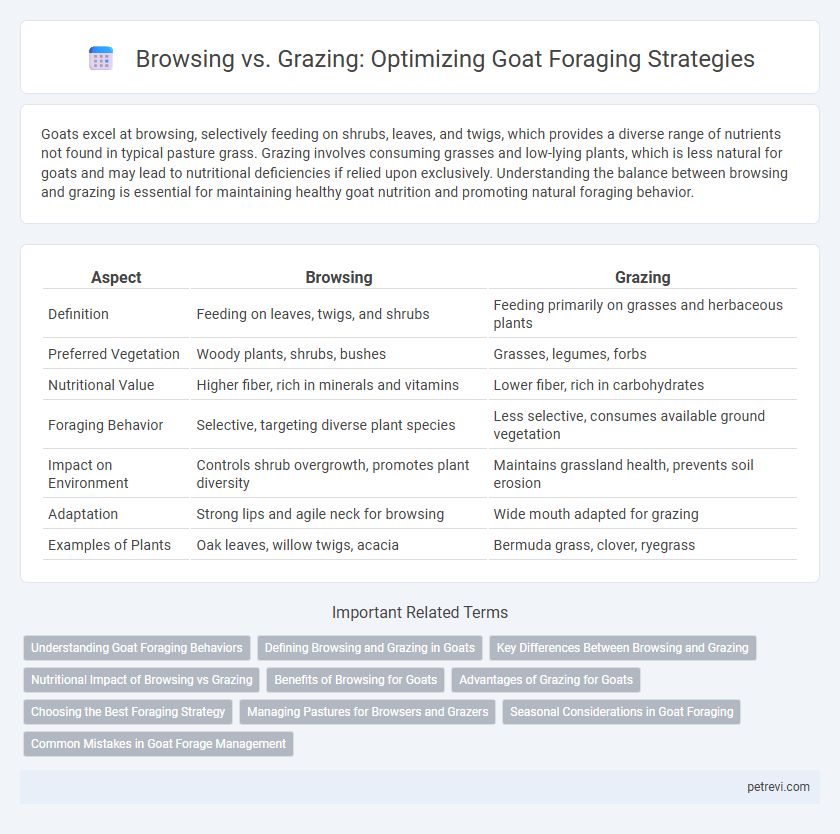Goats excel at browsing, selectively feeding on shrubs, leaves, and twigs, which provides a diverse range of nutrients not found in typical pasture grass. Grazing involves consuming grasses and low-lying plants, which is less natural for goats and may lead to nutritional deficiencies if relied upon exclusively. Understanding the balance between browsing and grazing is essential for maintaining healthy goat nutrition and promoting natural foraging behavior.
Table of Comparison
| Aspect | Browsing | Grazing |
|---|---|---|
| Definition | Feeding on leaves, twigs, and shrubs | Feeding primarily on grasses and herbaceous plants |
| Preferred Vegetation | Woody plants, shrubs, bushes | Grasses, legumes, forbs |
| Nutritional Value | Higher fiber, rich in minerals and vitamins | Lower fiber, rich in carbohydrates |
| Foraging Behavior | Selective, targeting diverse plant species | Less selective, consumes available ground vegetation |
| Impact on Environment | Controls shrub overgrowth, promotes plant diversity | Maintains grassland health, prevents soil erosion |
| Adaptation | Strong lips and agile neck for browsing | Wide mouth adapted for grazing |
| Examples of Plants | Oak leaves, willow twigs, acacia | Bermuda grass, clover, ryegrass |
Understanding Goat Foraging Behaviors
Goat foraging behaviors vary significantly between browsing and grazing, with browsing involving selective feeding on shrubs, leaves, and woody plants, while grazing focuses on consuming grasses and herbaceous vegetation. Understanding this distinction is crucial as goats possess a naturally browsing diet due to their digestive system and dental structure adapted for processing varied plant materials. Recognizing their preference for browsing supports effective pasture management and dietary planning to enhance goat health and productivity.
Defining Browsing and Grazing in Goats
Browsing in goats involves feeding on leaves, twigs, and shrubs from trees and bushes, allowing access to diverse, nutrient-rich plant parts. Grazing refers to consuming grasses and herbaceous plants typically found on pasturelands, which forms the bulk of their diet in open fields. These distinct foraging behaviors enable goats to adapt to varied environments and dietary needs effectively.
Key Differences Between Browsing and Grazing
Browsing involves goats feeding on leaves, twigs, and shrubs, while grazing refers to eating grasses and low-growing vegetation. Key differences include browsing's preference for higher-growing plants with more fibrous content and grazing's reliance on ground-level herbaceous plants. Browsing typically provides more varied nutrients and requires goats to adapt to different plant structures compared to grazing.
Nutritional Impact of Browsing vs Grazing
Browsing provides goats with a diverse intake of leaves, twigs, and shrubs, rich in secondary metabolites and essential minerals that promote better overall nutrition and immune function. Grazing on grasses offers higher carbohydrate content and fiber, supporting energy requirements and digestive health but may lack the variety of micronutrients found in browsing plants. Balancing browsing and grazing optimizes nutrient intake by combining protein-rich browse with energy-sustaining grazing material for improved goat growth and productivity.
Benefits of Browsing for Goats
Browsing offers goats access to a diverse diet rich in nutrients, including leaves, twigs, and shrubs, which supports optimal rumen health and digestion. Consuming a variety of plant materials improves immunity and enhances growth rates through a balanced intake of proteins, vitamins, and minerals. This natural foraging behavior reduces parasite loads by avoiding heavily grazed pastures and promotes sustainable land management by controlling brush and invasive species.
Advantages of Grazing for Goats
Grazing offers goats a diverse diet rich in nutrients by allowing them to consume a variety of grasses, herbs, and shrubs, which enhances their overall health and digestion. This natural foraging behavior helps maintain soil health through even vegetation management and reduces the risk of overbrowsing on specific plants. Grazing also supports the goats' natural instincts, improving their wellbeing and reducing stress compared with restricted browsing environments.
Choosing the Best Foraging Strategy
Goats exhibit both browsing and grazing behaviors, with browsing involving feeding on leaves, shrubs, and twigs, while grazing consists of eating grasses and low-growing plants. Browsing is typically more efficient in nutrient uptake and provides a varied diet rich in essential minerals, making it the preferred strategy in environments with diverse vegetation. Grazing offers abundant forage but may lack sufficient nutrients, so selecting browsing over grazing optimizes goat health and productivity in many foraging systems.
Managing Pastures for Browsers and Grazers
Effective management of pastures for goats requires differentiating between browsing and grazing behaviors to optimize forage availability and nutrition. Browsers primarily consume shrubs, leaves, and twigs, necessitating the maintenance of diverse woody vegetation and shrub layers within the pasture. Grazers focus on grasses and herbaceous plants, benefiting from rotational grazing systems that promote grass regrowth and prevent overgrazing, ensuring sustainable pasture productivity for mixed feeding strategies.
Seasonal Considerations in Goat Foraging
Goat foraging behavior shifts with seasonal changes, influencing browsing versus grazing patterns due to variations in plant availability and nutritional content. During spring and early summer, goats favor browsing on shrubs and broadleaf plants rich in protein, while mid to late summer encourages increased grazing of grasses as browse quality declines. Seasonal drought or cold periods further drive goats to adapt their diet, emphasizing more woody browse or surviving on lower-quality forage to maintain body condition.
Common Mistakes in Goat Forage Management
Goat foraging often suffers from the common mistake of confusing browsing with grazing, leading to inappropriate forage allocation and nutritional imbalances. Browsers prefer shrubs, leaves, and twigs, while grazers eat grasses and herbs; neglecting this distinction causes reduced feed intake and digestive health issues. Properly managing forage diversity by providing access to both browse and graze improves goat productivity and overall well-being.
Browsing vs Grazing for Goat Foraging Infographic

 petrevi.com
petrevi.com